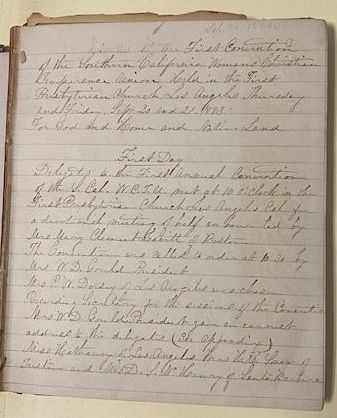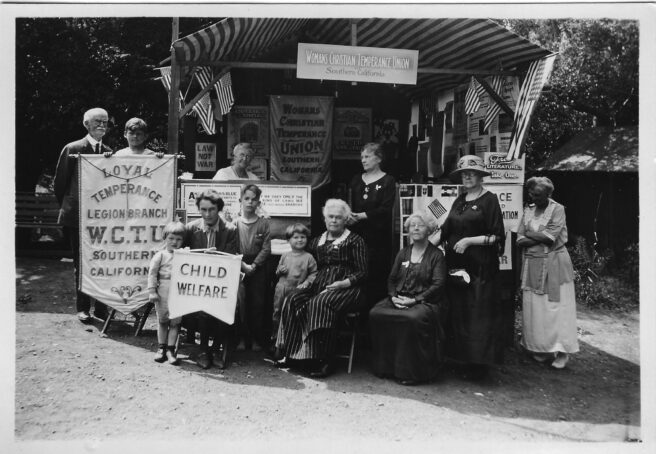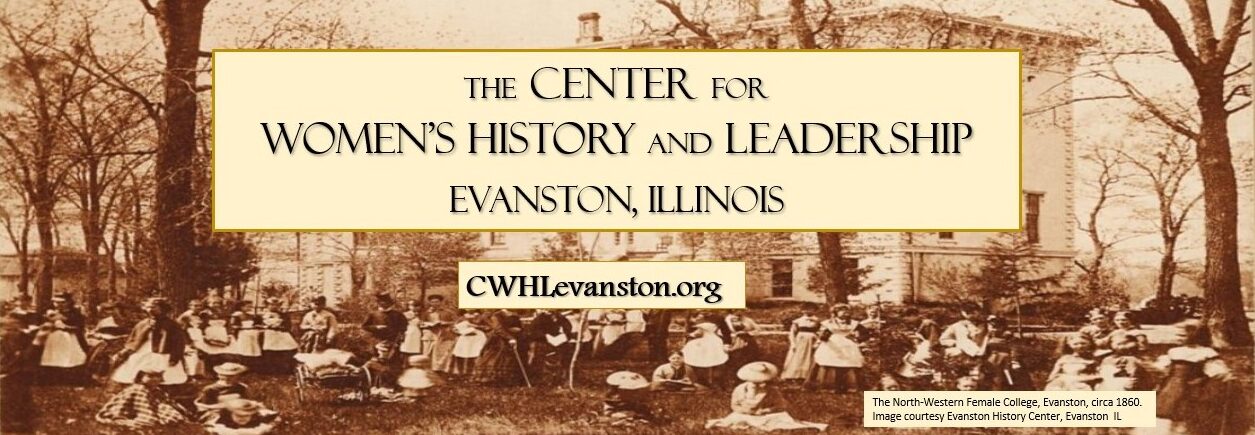By Kristin Jacobsen, Assistant Archivist, Frances Willard House Museum and WCTU Archives
Men may have dominated the California Gold Rush in the mid-nineteenth century, but the women of the state were energized by a longer-lasting undertaking – the temperance movement. A newly available collection of historical records tells the story of some of these women, the members of the Woman’s Christian Temperance Union (WCTU) of Southern California.

WCTU members were some of the most active women of their time in one of the largest groups for women of the late nineteenth and early twentieth centuries. This extensive collection, housed at the Frances Willard House Museum & WCTU Archives in Evanston, Illinois, brings attention to the activities of the women of the Southern California WCTU, who fought against alcohol and a host of other threats to their homes and families. These comprehensive records, spanning the years 1883-2008, are of interest to genealogists and to researchers in a variety of fields, including history, women’s studies, political science, religion, rhetoric and communication, and sociology.
The origins of the woman’s temperance movement in California go back to the 1870s. After the winter of 1873-74, word spread of a remarkable series of events in which thousands of women in communities across the country marched into saloons praying, singing hymns, and reading from the Bible. The goal of the Woman’s Crusade, as it was called, was to convince the owners of bars, drug stores, and hotels to either close or sign a pledge to stop selling alcohol.[1] While the Crusade was largely a movement of the Midwest and East, women in California were inspired by the idea that they could seize control of a problem issue, in this case abuse of alcohol and its devastating effects on families.
Temperance advocates were already active in California at the time of the Woman’s Crusade. They pushed the state legislature to pass a local option law allowing communities to decide whether or not to sell alcohol, for example, and faced unfriendly mobs when campaigning to pass many of these options in towns and cities. The Crusade ignited a new wave of activity in the state. Women in Grass Valley, northeast of Sacramento, organized as the Woman’s Temperance Union on March 25, 1874, just three months after the start of the Crusade and almost eight months before the founding of the national WCTU.[2]
The first woman’s temperance group in Southern California was the Women’s Temperance Association of San Diego, organized in July 1882. When national WCTU President Frances Willard visited California in 1883, she personally brought the San Diego group under the WCTU umbrella. She also organized other unions in Southern California that year, including Los Angeles, a fact that is recorded with pride on the first page of the group’s handwritten record book.[3]

At the time of Willard’s visit, the California WCTU included the entire state. Almost from its founding, WCTU leaders were concerned about the state’s vast geographic area. They called a convention in Los Angeles in September of 1883 to propose separating California into Northern and Southern unions, encouraging the division because of “the bigness of the territory, the expense of travel, and the impossibility of one set of officers to give adequate supervision over so vast a field.”[4] The motion passed, and California has been divided into two state-level administrative units ever since, although border areas have occasionally changed jurisdiction.
The collection, donated by the WCTU of Southern California, contains records dating back to its establishment as a separate state-level unit in 1883. Records include organizational and financial material from state, county, and city or town unions, as well as photographs, publications, scrapbooks, and three-dimensional artifacts. It also includes biographical information about individual Southern California WCTU members, many of whom went on to hold positions in the national and world WCTU, in the suffrage movement, and in other women’s organizations.
Especially useful are state yearbooks, often called Annual Reports or Annual Meeting Minutes, which date between 1883-1994 and contain detailed reports from state-level departments and local unions. Also of great interest are issues of the Southern California White Ribbon, the state WCTU’s monthly newspaper, which cover the period from 1891 to 1971.
As the records show, the organization was interested not only in prohibiting alcohol but also in broader social and political reforms such as woman suffrage, prison reform, labor and child welfare laws, dress reform, and increasing the age of consent for sex. For example, in the Yearbook for the second convention of the Southern California WCTU in 1884, members were already talking about branching beyond alcohol to raise awareness of the dangers of tobacco and opium. Overall, the collection provides a remarkably well-documented look at a women’s organization that remained active over the course of one hundred years.

The collection includes a number of unexpected finds, as well, including a box of opium pods that were used in anti-narcotics demonstrations. One folder holds a 1940 letter from the Wilmington Union shows just how passionate WCTU members were about their local conventions, which that year was held at a Presbyterian Church in the Los Angeles area. Olive M. Potter, corresponding secretary, wrote that church officials “have informed this union that the pulpit in that church was considerably injured by strokes of the gavel during the Convention sessions. This injury has now been repaired and a bill for the repair of same has been presented to the union and amounts to the sum of $7.00.”
For more information on the collection, see the full description and list of contents on the Willard House Museum & WCTU Archives website, or contact Assistant Archivist Kristin Jacobsen at assistantarchivist@cwhlevanston.org.
[1] Kristin Jacobsen, “Launching the ‘Last Call’: The Women’s Crusade against Alcohol, 1873-1874” [blog post], https://cwhlevanston.org/birth-of-the-wctu-temperance-women-ride-a-national-wave/.
[2] Information about early WCTU and temperance in California is from Dorcas James Spencer, A History of the Woman’s Christian Temperance Union of Northern and Central California. Oakland, Cal: West Coast Print. Co, 1920. Southern California WCTU background is from two published histories: Mary Alderman Garbutt, Victories of Four Decades: A History of the Woman’s Christian Temperance Union of Southern California 1883-1924, [1924]; and Jennie Ray Thompson, Victories of Four Decades: A History of the Woman’s Christian Temperance Union of Southern California 1924-1964, Woman’s Christian Temperance Union of Southern California, 1966.
[3] Secretary’s Book, Los Angeles Union, Box 17, Folder 15, Records of the Woman’s Christian Temperance Union of Southern California, Frances Willard House Museum and Archives, Evanston, Illinois.
[4] Garbutt, 16.

